Menus
- Kawa duel
- Engine concepts with different approaches
- Ninja 16 kilograms lighter than the ZXR
- Country road is no substitute for a racetrack
- Conclusion: almost no similarities
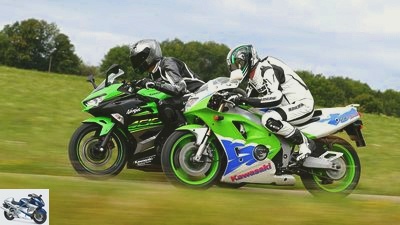
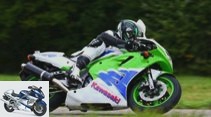
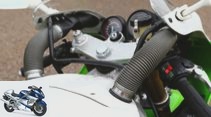
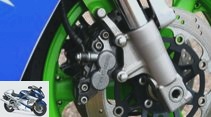
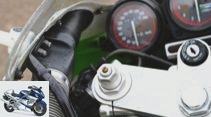
14th photos
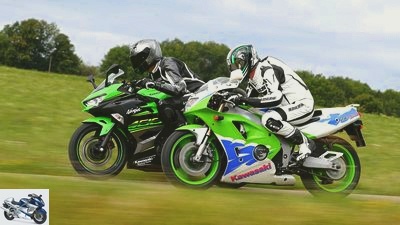
1/14
Basically, the ZXR 400 owes its creation to the TT on the Isle of Man.

2/14
Kawasaki ZXR 400.
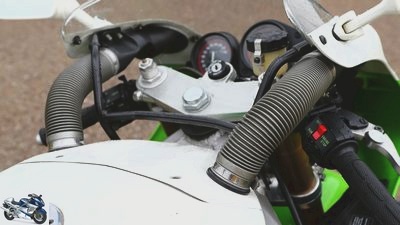
3/14
Because the TT-F3 is designed as a silhouette formula, the ZXR 400 and 750 received the much ridiculed vacuum cleaner hoses.
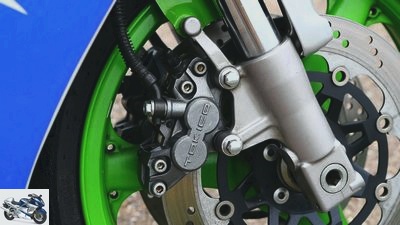
4/14
A thick front wheel axle, powerful four-piston calipers and the adjustable 41 fork are able to cope with the increased racing pace.
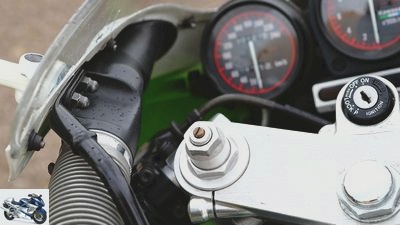
5/14
The ZXR has a solid clamp.
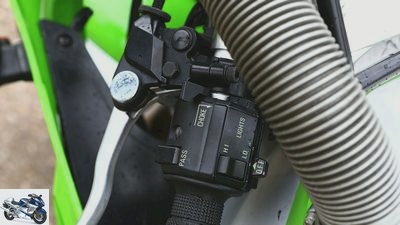
6/14
The adjustable clutch lever was a bonus.
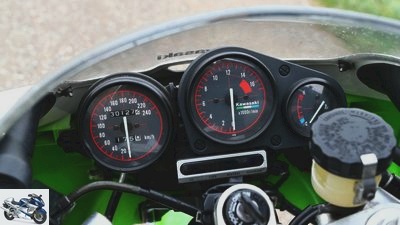
7/14
The cockpit of the ZXR 400.
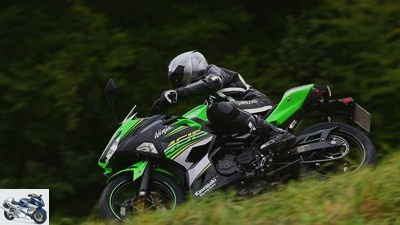
8/14
Kawasaki Ninja 400.
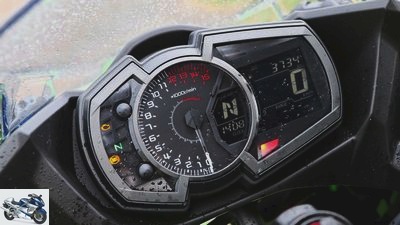
9/14
While the speedometer of the ZXR 400 can easily be dismantled for racing, the electronic cockpit of the Ninja 400 integrates numerous displays in one indivisible unit.
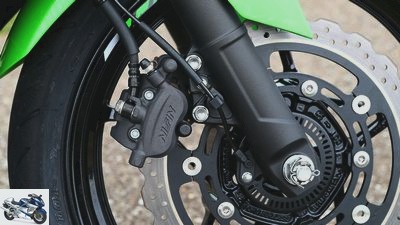
10/14
The conventional fork is not adjustable, the single-disc brake with double-piston floating caliper is kept simple, but quite effective.
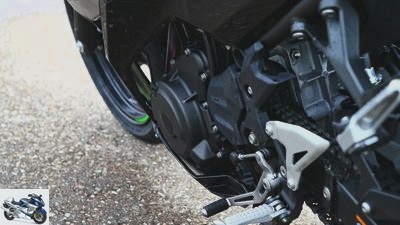
11/14
The slim alternator demonstrates technical progress in neglected details.
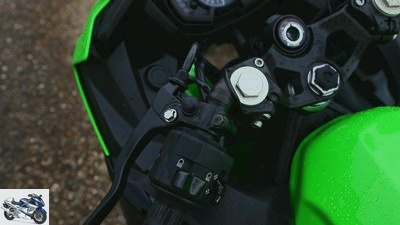
12/14
The same goes for the smooth slipper clutch, the lever of which is not adjustable.
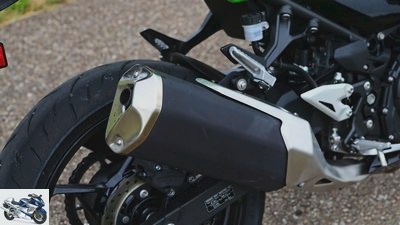
fact
13/14
The two-in-one exhaust system sounds contemporary – namely very discreet.
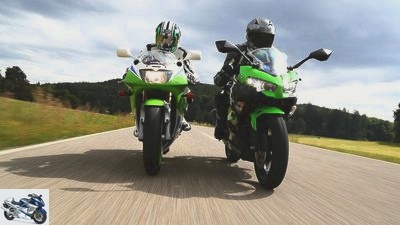
14/14
Left a racer, right an all-rounder.
Kawasaki ZXR 400 and Ninja 400 in comparison test
Kawa duel
Basically, the Kawasaki ZXR 400 owes its creation to the TT on the Isle of Man. The modern Kawasaki Ninja 400 drives by and listens in amazement to the high-speed tale of another time.
E.nde 1976 the FIM, Federation Internationale de Motocyclisme, revoked the status of a world championship run from the Tourist Trophy on the Isle of Man. Because the government of the island feared for the income from TT tourism, it created a new World Championship title, the TT formulas one, two and three, together with the British motorcycle sport association ACU. The Formula 3 races were advertised for motorcycles with two-stroke engines of up to 250 cm³ and four-stroke engines up to 400 cm³, Formula 2 for two-stroke engines up to 350 and four-stroke engines up to 600 cm³, while the large class combined two-stroke engines up to 500 and four-stroke engines up to 1,000 cm³. The racing machines had to be built on the basis of series motorcycles, tuning measures were regulated. This cubic capacity and the idea of a standard base for racing machines gave important impulses for the development of motorcycle racing. They extend to the Superbike World Championship as it exists today.
Buy complete article

Kawasaki ZXR 400 and Ninja 400 in comparison test
Kawa duel
What does that have to do with the two Kawasakis?
A whole lot. Because while the TT-F3 World Championship was held on the Isle of Man and later on other racetracks only until 1981, it celebrated a happy resurrection in Japan from 1984 and continued up to and including 1991. During this time, all Japanese manufacturers developed elaborate small super sports cars, Honda, Suzuki and Yamaha even two and four-stroke engines in parallel. Unfortunately, only a few of these precious items came to Europe. Only the Honda VFR 400 R – expensive and rare -, the Suzuki RGV 250 and the Kawasaki ZXR 400 were officially imported.
The Kawasaki ZXR 400 is sporty and ambitious.
What a difference their racing orientation makes compared to the current Ninja 400! Because despite its distinctive fairing front, which is strongly reminiscent of the Superbike ZX-10R, the Ninja 400 with a tubular steel frame, conventional fork and single-disc brakes at the front and rear is designed as an inexpensive all-round motorcycle that has sporty talents but no racing ambitions. This is exactly what the ZXR 400 shows in every single detail, from the sturdy upside-down fork to the four-piston fixed calipers of the front double disc brake, the aluminum bridge frame to the lever system of the rear wheel suspension and the rear wheel swing arm welded from extruded profiles. Kawasaki has recreated the superbike ZXR 750 in small size. Or was it the other way around and the 750 is an enlarged 400? Not unlikely.
Engine concepts with different approaches
The engines deserve special attention, especially since they are mostly hidden behind the fairing. First there is the inline four-cylinder of the ZXR with a 57 millimeter bore and 39 millimeter stroke. This is an extremely short stroke in absolute terms, but not in relation to the bore. In this respect, the 600 super athletes are even more extreme. Either way, the short stroke allows the small Kawasaki immense speeds of over 14,500 rpm as well as valve cross-sections that ensure an efficient mixture supply in such regions. The four valves per combustion chamber are operated via rocker arms, which in turn enable full cams and high valve acceleration. So it’s no wonder that the top performance of the small barrel organ is impressive even in series production. Contemporary measurements always yielded 65 to 68 hp. Extrapolated to the liter displacement, that’s between 162.5 and 172 hp. In the early 1990s, there were no 1000s with this performance. On top of that; competent tuners easily tickle more than 80 hp from this engine.
The Kawaski Ninja 400 is designed for owners of the driver’s license class up to 48 hp.
The drive of the Ninja 400 follows a completely different approach. Designed for the driving license class up to 48 hp, it does not strive for high peak performance. Therefore and to save production costs, it gets by with two cylinders and is relatively less short-stroke than the four-cylinder. Unlike most modern in-line cylinders, it moves the connecting rod and piston with a 180 degree instead of 90 degree crank pin offset. The inertia forces balance each other out, but not the inertia moments, which is why he got a balancer shaft to dampen vibrations. As different as the technology, so differently do the engines present themselves. The two-cylinder starts promptly and chugs very discreetly at idle. The four-cylinder is demanding and expressive, wants precisely metered choke support and requires some organ of the starter until it ignites. But then a concerto grosso begins; it sucks in with a hiss, scratches the timing chain, clacks with the pistons that are still cold and trumpets surprisingly deep from the four-in-one exhaust system, which is made entirely of stainless steel.
Ninja 16 kilograms lighter than the ZXR
Similar when starting up. On the Ninja 400 you disengage the clutch with the pull of a finger, engage first gear and drive away at low speed, easily and casually. On the ZXR, the left hand pulls the clutch lever against tight spring force, the left foot must first feel the high placed notch before it can engage first gear, which announces readiness with a dry “clone”. Starting with the high-revving engine and the relatively long first gear requires carefully measured clutch grinding at at least medium speeds. If you want it quick, you should engage the clutch at around 8,000 rpm. The driving dynamics of the ZXR 400 are therefore not simply available, but only with concentration and commitment.
The two test candidates wheel to wheel.
This knowledge is confirmed with every kilometer, regardless of whether in city traffic, on the country road or the motorway. The ninja two-cylinder doesn’t offer as much top performance as the ZXR four-cylinder, but it has a relatively strong center, which – measured by the cubic capacity – enables almost lazy driving. The chassis of the ninja is also less demanding. It’s 16 kilograms lighter than the ZXR, has narrower wheels and tires, and places the driver in an upright position. Easy turning and a good overview ensure a carefree driving experience, the gentle damping for comfort. You let the ninja run quickly through the curves, relax actively and rarely come up with the idea of tweaking the high-revving engine to maximum power or braking sharply to the next curve.
Country road is no substitute for a racetrack
The ZXR 400 urges its drivers to do just that. Especially the machine that we had available for our trip across the Swabian Alb. She suffered from a mild form of carburetor disease after standing for a long time. The gasoline was probably a little too high in the float chambers, because although it pulled through properly in the middle range between 6,000 and 10,000 / min – yes, that’s the middle for her – it only showed what it was really capable of. With an enthusiastic and enthusiastic outcry, the four-cylinder turns over 14,000 rpm in an instant. On the open autobahn, he fired the little Kawa after a short run up to a speedometer of just under 220 km / h. Much too fast for the brave ninja chasing after. Perfectly maintained specimens of the ZXR 400 develop their power more evenly, but that changes little in the driving style that demands them.
This is what the ZXR 400 instruments look like.
Even a country road with the most demanding curves is no substitute for a race track. Nevertheless, there were indications that the damping of the Ninja reaches its limits in the area where you begin to understand on the ZXR why the fork and shock absorber are so tightly matched and torsionally rigid. Their steering precision and feel for the front wheel are still impressive today. The only point where the ZXR no longer meets today’s standards is the seating position. The bench is too low, the footrests are mounted as high as they have to be to avoid inclination. This forces the knee to be painfully tight and reduces the driver’s mobility. Who nevertheless never turns his eyes from her during a break and thinks about where he could get a firm, four centimeter thick seat cushion from.
Conclusion: almost no similarities
Both are or were produced by Kawasaki and have engines with around 400 cm³ displacement. But that was it with the similarities of the Ninja and ZXR 400. While the Ninja with its simple construction and pleasing manners offers a favorable price-performance ratio for customers and manufacturers, the ZXR 400 is built with downright indulgent effort. Today it could hardly be cheaper than a Yamaha YZF-R6, which costs around 14,000 euros. But who should buy them for such a price, when even the possibilities of using them in racing are limited to those offered by a few racing training organizers? Anyone who falls for the charm of the little screamer should secure a well-preserved specimen in good time, drive it and look after it. As a reminder of a short period of time in which such wonderfully unreasonable motorcycles could be bought.
Related articles
-
New Kawasaki Ninja ZX-10R (2016) in the driving report
Kawasaki 18 pictures Kawasaki 1/18 Kawasaki Ninja ZX-10R. Kawasaki 2/18 Kawasaki Ninja ZX-10R. Kawasaki 3/18 Kawasaki Ninja ZX-10R. Kawasaki 4/18 Kawasaki …
-
Kawasaki Ninja ZX-10R – old versus new compared
fact 24 photos www.factstudio.de 1/24 Kawasaki ZX-10R: old versus new. www.factstudio.de 2/24 Kawasaki ZX-10R 2016: Brembo instead of Tokico, “balance…
-
Kawasaki Z 900 RS (2018) in the test
Jacek Bilski 23 photos bilski-fotografie.de 1/23 Kawasaki Z 900 RS: technology from the Z 900, style based on the epoch-making Z1. bilski-fotografie.de…
-
Comparison test: Honda CX 500-650 Turbo, Kawasaki Z 750 Turbo, Suzuki XN 85, Yamaha XJ 650 Turbo
Jahn 21 pictures Jahn 1/21 The preload of the central spring strut of the Suzuki can be easily adjusted. Jahn 2/21 Tight corners and fast …
-
Comparison test Honda CBR 250 R against Kawasaki Ninja 250 R
fact comparison test: Honda CBR 250 R against Kawasaki Ninja 250 R 250 super sports car for beginners Content of Honda’s CBR 250 R and the Kawasaki Ninja 250 …
-
Comparison test of superbikes, part 1: Country road
Jorg Kunstle 36 pictures 1/36 Comparison test Superbikes: Aprilia RSV4 RF, BMW S 1000 RR, Kawasaki ZX-10R, Yamaha YZF-R1M. 2/36 …
-
Jahn Top test Kawasaki ZRX 1200 R Greetings from Eddie The Kawasaki tradition of the strong in-line four-cylinder is not embodied as emphatically as the…
-
Jahn Top test Kawasaki ZX-12R ZX-12Air With its 175 hp engine, Kawasaki’s green racer bridges distances as if in flight and, if necessary, pushes the…
-
fact comparison test Crosser in suspension It seems clear that the four-stroke crossers in the small class will soon take over the helm. But now?…
-
BMW R nineT and BMW R nineT Scrambler in a comparison test
www.bilski-fotografie.de 16 photos www.bilski-fotografie.de 1/16 In the course, the nineT sisters had to prove their chassis quality and steering…